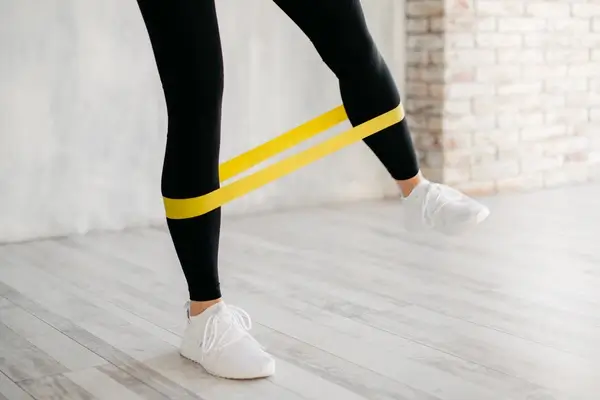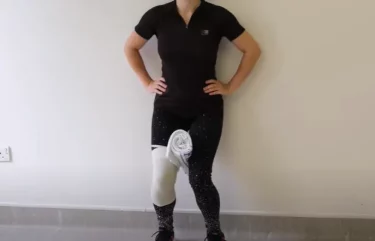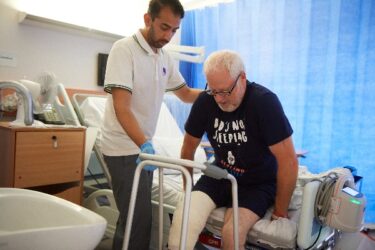If you’ve just had knee surgery, it’s likely you’ve got a few questions. How long will my recovery last? When will I be able to drive again? These are among the most common, but for the sportier amongst us, the questions are likely more specific: when can I get back on the court, back on the bike, or back in the pool?
These are the questions this article seeks to answer, so join us as we take a look at sport and exercise after knee replacement surgery.

Private knee surgery at a glance:
- Surgery within just 4-6 weeks
- Costs £11,799
- Available at a range of our UK locations
- Finance options available
Call us on: 0333 060 8149
Wellsoon self-pay surgery
Choose Wellsoon self-pay surgery from Practice Plus Group. With no hidden costs, you’ll pay less than you might think and be back to your best sooner than you thought.
- Surgery in 4 to 6 weeks*
- No hidden costs
- Flexible finance options
To chat about Wellsoon self-pay surgery options, call our Private Patient Advisors today, on 0330 818 8945. Alternatively, you can email us on privatepatient@practiceplusgroup.com
Why is keeping in shape after knee replacement surgery important?
Whether you’ve had a partial knee replacement or total knee arthroplasty, one of the key factors following the operation is to stay active. In the early stages after knee replacement surgery, it’s important to follow and complete the exercises devised by your physiotherapist. These will help to strengthen your muscles and improve the range of motion in the affected knee.
In the weeks and months following knee joint replacement, it’s also crucial to maintain a healthy weight. Not only is this good for your general health, it will also reduce the strain placed on the new joint as you move around.
Did you know?
According to a 2022 NHS report, 53.3% of knee replacements were carried out on female patients1.
What sports can you do after a knee replacement?
Following your procedure, it’s likely you’ll want to know whether it’s safe to play sport after a hip or knee replacement. The activities to avoid after a knee replacement are those that carry a high-risk of falling. Sports such as rugby, football and skiing should be avoided as these could cause damage to the new implant. Activities involving a lot of running and jumping should also be avoided, as well as sitting for prolonged periods of time.
Swimming, golf, walking, cycling and gardening after a knee replacement are all excellent options to explore to keep fit.
Can you play tennis after a knee replacement?
In a word: yes. Tennis is a great way of keeping fit while having fun doing so. You should follow the guidance from your doctor before returning to the court, but most knee replacement patients are given the green light to play.
This, however, is likely to come with certain conditions. Such as, initially playing on a clay court and in a doubles format. Doing both of these should significantly reduce the strain on your implant.
Your orthopaedic surgeon may also recommend you have a few lessons with a professional. When made aware of your condition, he or she should be able to advise on.
Playing golf after a knee replacement
For those that like to tee it up, there’s good news. You should be able to return to the greens between three and six months after your knee surgery. Your doctor may advise you to hire a buggy to get around the course in order to reduce the strain on your joint.
Prior to making a full return, you can pick up the clubs during your initial recovery. You should be able to practise putting after a month or so, while chipping can be practised after a couple of months.
Cycling after a knee replacement
Yes. The good news is cycling after knee replacement surgery is one of the activities recommended by doctors during recovery. You can expect to be back on a stationary bike within two weeks of your knee operation. Cycling on the road may take up to 12 weeks post-operation.
Playing football after a knee replacement
While some patients will have returned to the football field, it really isn’t recommended by doctors. Football carries a high risk of impact and falling, which can both be damaging to an implant.
High-impact sports after knee replacement
You should avoid high-impact sports after a knee replacement. Ask your doctor for more information, but they are likely to advise against activities such as rugby, football and skiing.
How long after knee replacement can you play sports?
The answer to this question depends on numerous factors. For example, it depends which sport you want to do. It also depends on how successful your operation was, and how closely you’ve been following your recovery physio plan.
Light exercise such as walking in the days following your surgery is encouraged by your doctor. Cycling on a stationary bike may be recommended within two weeks of your surgery. Cycling outdoors is unlikely to be recommended until up to three months after your operation.
Some sports that carry a high risk of falling or impact should not be attempted. These include rugby, skiing and football.
Pain in your knee?
If you’re experiencing knee pain, try our knee suitability quiz. It will give you an idea of whether you’d benefit from booking a consultation with one of our knee specialists.
What is the best exercise after knee replacement?
Aside from cycling and walking, the best exercises after your knee operation should be provided by your physiotherapist. They will devise an exercise program designed specifically for your needs. It will likely contain low-impact activities such as:
Straight leg raises
While lying flat on a bed, keep your affected leg straight and raise it about 12 inches off the bed. Hold it for up to five seconds before lowering back down.
Ankle pumps
these are a great way of reducing the swelling in your affected leg while strengthening muscles. While lying flat on the bed, pump your feet up and down while hinging at the ankle. You can also rotate your feet clockwise and anti-clockwise. These exercises can be done multiple times a day.
Wall slides
Place a rolled up towel between your legs and stand up straight with your back against a wall. Keeping your hands on your hips, slowly slide down the wall under you’re in a slight squat position. Hold for a few seconds and slide back up. Repeat this exercise 10 times.
Resistance band exercises after knee operation
The use of resistance bands can be extremely helpful following knee replacement surgery. They can help target specific muscles around the affected area while reducing the stress of impact exercises.
You should ask your physiotherapist to provide a list of resistance band exercises specific to your needs. Please note that while mild discomfort is ok, caution should be taken if you experience knee pain during the exercises.

Strength training after knee replacement
While patients should proceed with caution, strength training is generally encouraged following joint replacement surgery. When done with the right care and attention, strength training can be very beneficial to your recovery. This is because it can help build muscle around the affected joint, taking stress and strain off the new implant. In terms of encouraging longevity for an artificial joint, strength training can be extremely beneficial.
Walking after knee replacement
Aside from physiotherapy exercises, walking is one of the most important activities you can do following a knee replacement. It increases mobility while strengthening the muscles around the new joint. Initially, you’ll likely be given walking aids to help you, but after a week or so, you should be able to walk unaided.
Swimming after knee replacement
Swimming is encouraged after knee surgery as it is a low-impact activity. It should be done in moderation at first, but distances and frequency can be increased over time. To reduce the risk of infection, you should wait until your wound has fully healed to get into the pool.
Increasing your range of motion
In the time after your surgery, the following will help increase your range of motion and speed up your recovery:
- exercises from your physiotherapy plan
- walking (initially with the aid of crutches or a frame)
- cycling (on a stationary bike).
Climbing stairs
In the days after your surgery, you’ll need to learn who to climb stairs with the use of crutches. This can be done with the help of doctors and nurses. As your recovery continues, you should be able to climb stairs without needing walking aides. Studies show that 95% of patients have no problem climbing stairs following a successful recovery from knee replacement surgery.
Standing from sitting
Within a day of your operation, you’ll be encouraged to stand with the help of the doctors and nurses. This marks the start of your road to recovery.
Yoga
Yoga is a good activity for patients following a knee replacement. This is because it’s a low-impact exercise that raises the heart rate with minimal stress on the joints. It improves mobility, strengthens muscles and improves fitness and quality of life.
Exercises to avoid after knee replacement
There are a number of exercises you should avoid after a knee replacement. Generally, these include ones that involve bending your knee, such as squats. These place a lot of stress and strain on your new joint, and can leave it vulnerable to damage.
You should avoid the following exercises and activities:
- football
- rugby
- skiing
- anything with a high chance of impact.
Tips for staying active after knee surgery
It’s all well and good talking about keeping active after knee surgery, but it’s another thing doing it. Our tips below will help provide some tactical guidance to help keep you motivated for a healthy post-surgery lifestyle.
1. Choose safe activities
This means you should choose activities with a low risk of both falling and impact. Among these are walking, swimming, cycling and golf. Although considered a relatively high-impact exercise, you may be able to return to running following knee surgery.
Unsafe activities include rugby, football and skiing. You should avoid these as they carry a high risk of falling and therefore damage to the new joint. Ask your doctor for more information about what you should and shouldn’t do post-surgery.
2. Do exercise you love
Although after your operation you may be a little more limited in the exercises you can do, finding one you enjoy is naturally going to make it a lot easier to stay motivated.
3. Keep it consistent
Just as with exercise pre-surgery, consistency is key. Doctors recommend 150 minutes of exercise every week as a minimum for most adults. Knee surgery patients should avoid this level of exercise in the days and weeks following the operation. However, after a successful recovery and with the guidance of your doctor, you should be able to return to regular weekly exercise.
4. Rest when you need to
In your recovery, rest is just as important as following your exercise plan. Not getting enough rest can impact your chances at making a full recovery and potentially damage your new implant.
5. Don’t skip stretches and mobility work
Stretching and mobility work are just as important as exercise, especially in the days and weeks following your knee surgery. These will help strengthen the muscles around the affected joint and give you the best chance of making a full recovery.
6. Maintain a healthy diet
This is just as important for knee surgery patients as it is for the general public. Maintaining a good diet will help you remain at a healthy weight. This reduces the amount of stress and strain put on the new joint. Overweight knee surgery patients are less likely to make a full recovery.
7. Get lots of sleep
Don’t underestimate the power of sleep in your recovery. Getting lots of sleep plays a huge part, not only in allowing the affected area to heal, but also in terms of your mental wellbeing. Poor quality or a lack of sleep can negatively affect your mood. It can also cause fatigue during the day and disrupt your recovery.
8. Focus on strength and flexibility
In the days and weeks after your total knee replacement surgery, the focus will be on improving the range of motion in your knee. Initially, your knee will be stiff and sore, so it’s crucial to work on its flexibility. This is taken on a week-by-week basis and will be documented in your recovery plan.
9. Work with a physiotherapist or special trainer
Following your knee surgery, your physiotherapist will provide a detailed recovery plan specific to your needs. This will be full of exercises and stretches designed to aid your recovery. It is important to follow these plans to give yourself the best possible chance of a full recovery.
A specialist trainer can also help with your return to a specific sport or activity. For example, if you want to return to the tennis court, it’s a good idea to book some lessons with a professional. He or she will be able to offer hints and tips as well as coaching specific to your post-surgery needs.
Getting back on your feet with Practice Plus Group
Whether you’ve had knee surgery or a hip replacement, at Practice Plus Group Hospitals, we’re passionate about giving patients a positive experience with excellent clinical outcomes. Our care is personalised with consultants and nurses with you every step of the way.
Sources and references
Exercise and knee surgery FAQs
Not quite found what you’re looking for? Our exercise after a knee replacement FAQs can help.
Following your knee surgery, you’ll be encouraged to start light exercise. However, it’s crucial to follow the guidance of your physiotherapist and not to overdo it. They will likely recommend walking with the help of crutches in the first few days. After that, most patients are encouraged to do some cycling. This will be on a stationary bike and is usually for around 20 minutes a day for the first couple of weeks.
In the days following your operation, exercises should be short in duration. Exercising for between 15 – 20 minutes a day is generally recommended. As the weeks go by in your recovery, the duration can be increased slowly and with the guidance of your doctor.
Yes. Doing too much too soon after your operation can put you at risk of damaging your implant. Exercising should be between 15 – 20 minutes in the days following your operation. The duration can then be increased slowly following the guidance of your consultant.
Yes and no. In the days and weeks after your surgery, it’s too soon to return to the gym. Exercises should be kept light to avoid damaging your new implant and help recovery. Patients can typically get back in the gym around 12 weeks after their operation, but this varies from patient-to-patient. Once you return to the gym, you may not be able to do the same exercises as before your surgery. Ask your consultant for more guidance.
It depends on your definition of athletic. If you make a full recovery and follow the physiotherapy plan in your recovery, you should be able to enjoy a healthy, active lifestyle. However, you will be advised against playing some sports like rugby, football and skiing. Cycling, walking and swimming are encouraged, and you’ll also be able to get back in the gym for strength training. There are many famous athletes that have a knee replacement!
It depends on how much pain you’re experiencing. Mild discomfort is usually fine; it’s a sign that your muscles are working hard and strengthening. High levels of pain indicate that you’re putting the implant under too much stress. If you experience a lot of pain during exercise, you should stop immediately. Ask your doctor about how to proceed.











